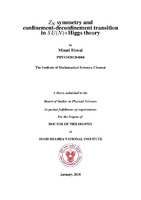- DSpace Home
- →
- IMSc Theses/ Dissertations
- →
- IMSc Theses/ Dissertations
- →
- View Item
JavaScript is disabled for your browser. Some features of this site may not work without it.
| dc.contributor.author | Minati Biswal | |
| dc.date.accessioned | 2018-11-12T11:13:09Z | |
| dc.date.available | 2018-11-12T11:13:09Z | |
| dc.date.issued | 2018 | |
| dc.date.submitted | 2018 | |
| dc.identifier.uri | https://dspace.imsc.res.in/xmlui/handle/123456789/425 | |
| dc.description.abstract | In this thesis, we study the ZN symmetry and confinement-deconfinement (CD) transition in SU(N) Higgs theory. In the absence of the Higgs field, the Euclidean action is invariant under the ZN gauge transformation. This symmetry is spontaneously broken in the deconfinement phase as the Polyakov loop acquires non-zero thermal average value. This gives rise to N degenerate states in the deconfinement phase. In the presence of matter fields, the Euclidean action is not invariant under the ZN symmetry. This explicit symmetry breaking affects the CD transition. We carry out non-perturbative simulations of this theory to understand how the strength of the explicit symmetry breaking depends on the parameters of the theory. Our results show that in the Higgs phase, where the Higgs condensate is non zero, the ZN symmetry is explicitly broken. In the Higgs symmetric phase where the Higgs condensate is expected to vanish, the strength of the ZN symmetry breaking depends on the lattice cut-off, i.e. the number of points along the temporal direction (Nτ) of the Euclidean lattice. For vanishing bare Higgs mass and Higgs quartic coupling, the N=2 CD transition is found to be a crossover with finite explicit symmetry breaking for Nτ=4. For the same bare parameters, this transition turns out to be second order, accompanied by the realization of the Z2 symmetry for Nτ=8. We observe that for Nτ=4, the ZN symmetry is restored in parts of the Higgs symmetric phase. In the λ- κ plane ( λ Higgs quartic coupling, κ the gauge-Higgs interaction strength), the ZN symmetry is restored for κ > κ (λ). This κ (λ) line moves closer to the Higgs transition line with the increase in the number of temporal lattice points (Nτ). For Nτ=8 this line coincides with the Higgs transition line. Since for Nτ=8 with vanishing bare Higgs mass and Higgs quartic coupling the Z2 symmetry is realized, it will also be the case for all non-zero values of the bare Higgs mass. In contrast, in QCD, where the explicit symmetry breaking grows stronger with the decrease in the quark mass. | en_US |
| dc.publisher.publisher | The Institute of Mathematical Sciences | |
| dc.subject | Higgs Theory | en_US |
| dc.subject | HBNI Th138 | en_US |
| dc.title | Z _N Symmetry and confinement-deconfinement transition in SU(N)+ Higgs theory[HBNI Th138] | en_US |
| dc.type.degree | Ph.D | en_US |
| dc.type.institution | HBNI | en_US |
| dc.description.advisor | Sanatan Digal | |
| dc.description.pages | 102p. | en_US |
| dc.type.mainsub | Physics | en_US |
| dc.type.hbnibos | Physical Sciences |
Files in this item
This item appears in the following Collection(s)
-
IMSc Theses/ Dissertations
IMSc Theses/ Dissertations
